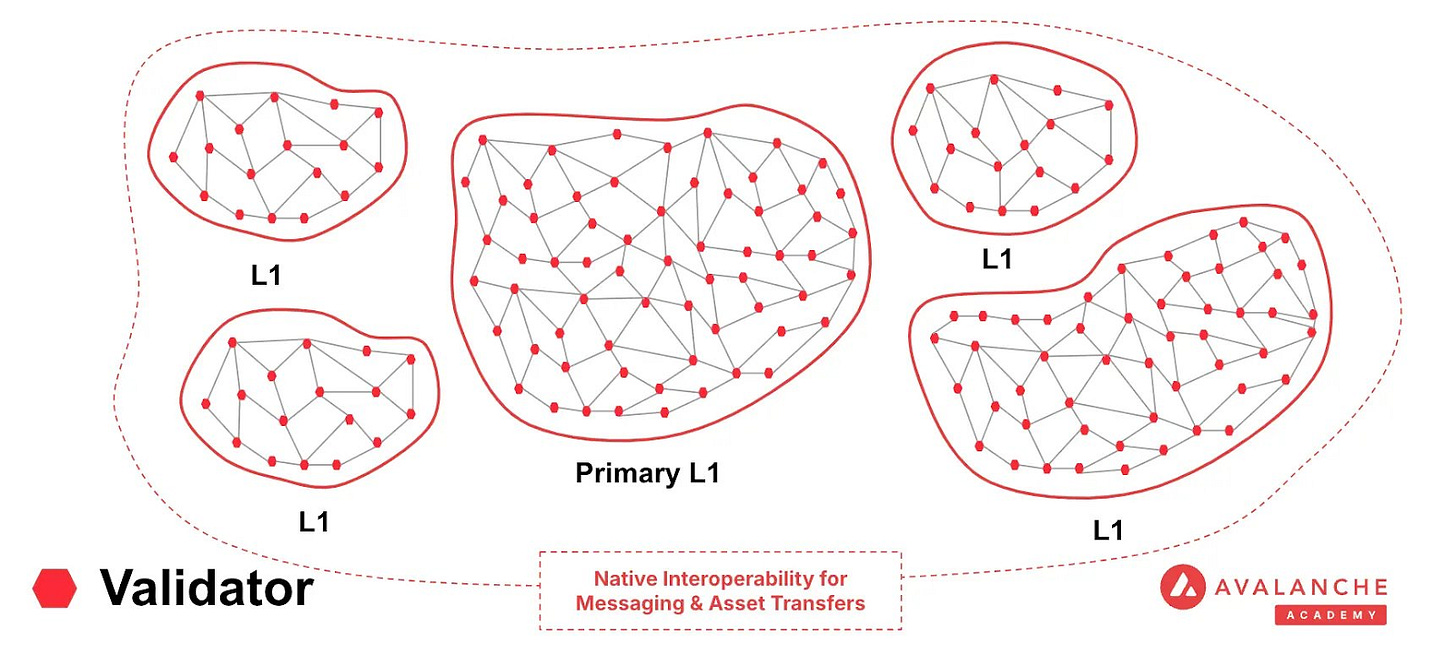Avalanche ICM and ICTT: Powering Native Cross-Chain Apps and Token Transfers
Discover how Avalanche’s native protocols simplify communication and token transfers across L1s without the complexity or compromise.
Interoperability in the blockchain space refers to the ability of different networks to communicate, share data, and interact seamlessly. It allows tokens, smart contract interactions, and messages to move fluidly between chains, empowering users and developers to tap into the full potential of decentralized systems.
However, today’s blockchain ecosystem is highly fragmented. Most blockchains operate as isolated environments with their own consensus rules, programming languages, and user communities. This siloed structure makes it difficult for assets and applications to move or interact across networks. As a result, it limits innovation, reduces liquidity, and creates a fragmented user experience. Think of it like international airports that don’t coordinate flight schedules or recognize each other’s passports. No matter how advanced each airport is on its own, global travel becomes disjointed and inefficient without coordination.
As blockchain adoption spreads across industries, finance, supply chain, gaming, and real estate, the need for cross-chain compatibility and unified infrastructure is becoming critical. Projects that solve this interoperability gap will lay the foundation for a more connected, scalable, and user-friendly Web3 ecosystem.
How Avalanche L1s Work and Why They’re Built Differently
Avalanche is renowned for its innovative scaling model built around customizable Layer 1 blockchains, previously known as Subnets. Each L1 operates as an independent blockchain with the flexibility to define its own rules, select its validator set, and run a tailored virtual machine (VM). This design allows developers to build chains optimized for specific use cases, whether it’s finance, gaming, real-world assets, or enterprise applications.
Because these chains operate independently of the primary Avalanche network, they avoid congestion and conflicts with the global state, resulting in high throughput and ultra-low latency. Developers also gain fine-grained control over network parameters, such as transaction fees, validator permissions, and even who can execute transactions or deploy smart contracts. This makes Avalanche an ideal platform for building scalable, secure, and compliant Web3 ecosystems.
Why Cross-Chain Development Has Been So Hard Until Now
Historically, blockchains operated in isolation, unable to natively communicate or transfer assets between one another. This fragmentation posed significant challenges for developers aiming to build multi-subnet or cross-chain applications, ultimately leading to a fragmented and restrictive user experience.
In the absence of a native interoperability framework, developers were forced to rely on centralized bridges or craft custom integrations to enable cross-chain functionality. These workarounds not only introduced security vulnerabilities and added complexity but also reduced composability, making it harder for applications to interact seamlessly across ecosystems.
ICM: Native Messaging Between Avalanche Chains
Avalanche Interchain Messaging (ICM) enables native cross-Avalanche L1 messages, allowing L1s to send messages to each other without needing external bridges or intermediaries. Think of it as giving every Avalanche chain a secure direct line of communication, where messages are verified by the validators of the sending chain and cryptographically trusted by the receiving chain. This offers:
Secure Communication: Messages come with cryptographic proof, removing the need for third-party relays.
Flexible Use Cases: Enables cross-chain apps, shared oracles, Token transfers, and state synchronization.
Enterprise Ready: Supports data privacy, compliance, and modular app design.
What Developers Can Actually Build With ICM
A game can trigger actions on a separate marketplace chain.
A price feed on one chain can be used by others.
Institutions can collaborate across secure L1s.
ICTT: Native Token Transfers Without Custom Bridges
Avalanche’s Interchain Token Transfer (ICTT) protocol builds upon the foundation laid by Interchain Messaging (ICM) to deliver seamless and secure token transfers between L1 blockchains within the Avalanche ecosystem.
Rather than creating another custom bridge, which often introduces new security risks and technical debt, ICTT leverages a set of audited, production-ready smart contracts. This approach minimizes the need for custom solutions while maintaining high standards of security and composability. With ICTT, developers can enable native, cross-chain token transfers without compromising user experience, trust assumptions, or protocol integrity.
Cross-Chain Currencies and Seamless DeFi: Use Cases for ICTT
New L1s can offer USDC or BTC without custom integration.
Multi-game ecosystems can share currencies.
Finance apps can interoperate without new infrastructure.
Why ICM and ICTT Matter for Builders, Businesses, and Institutions
Frictionless User Experience: Users can move assets and interact across apps without needing to switch chains or understand complex bridging mechanics.
Modular App Design: Businesses can create dedicated L1s for compliance, data privacy, or specific markets, and still coordinate across them.
Unified Token Standard: Without ICTT, a token might exist as multiple wrapped or synthetic versions across different Layer 1 chains. ICTT enables A unified token standard that works seamlessly across Avalanche L1s.
Consolidated Liquidity Across Chains: In a multi-chain world, fragmented tokens often result in fragmented liquidity pools, inefficient capital allocation, and increased slippage. Avalanche’s Interchain Token Transfer (ICTT) protocol solves this by enabling true interchain composability: the same token can be seamlessly used across DeFi protocols on multiple chains
Security and Compliance: By leveraging Avalanche’s native infrastructure, ICM and ICTT eliminate the need for third-party bridges, reducing attack surfaces and minimizing external dependencies. This built-in architecture significantly enhances auditability, trust, and regulatory alignment, making it ideally suited for institutional-grade applications that demand the highest standards of security and compliance.
Cost and Speed Efficiency: ICM and ICTT are built into Avalanche, offering near-instant messaging and token transfers with low fees.
A More Unified Avalanche: What ICM and ICTT Make Possible
ICM and ICTT elevate Avalanche into a truly interoperable blockchain ecosystem, one where communication and token transfers flow seamlessly across chains. By eliminating the traditional complexities and security risks of cross-chain development, these native protocols empower developers, businesses, and institutions to build advanced multi-chain applications with ease and confidence. Whether you’re building in DeFi, gaming, or enterprise infrastructure, Avalanche delivers the scalability of a multi-chain architecture with the usability of a unified platform, bridging performance with simplicity.
Learn More About ICM and ICTT
If you’re ready to dig deeper into the underlying design and tools powering cross-chain apps on Avalanche, these resources are a great place to start:
ICM & ICTT Architecture Overview: Gain big-picture context and architectural diagrams from the Builder Hub cross-chain overview.
Interchain Messaging (ICM) Course: Walk through key concepts like message verification, Teleporter contracts, and cross-chain use cases via the Avalanche Academy Interchain Messaging course.
Interchain Token Transfer (ICTT) Course: Learn how native token bridges and smart contracts enable secure, composable token movement using the Avalanche Academy Interchain Token Transfer course.
Dive into the Avalanche ecosystem today! Download the Core Wallet and unlock a world of seamless DeFi, NFTs, and more.






